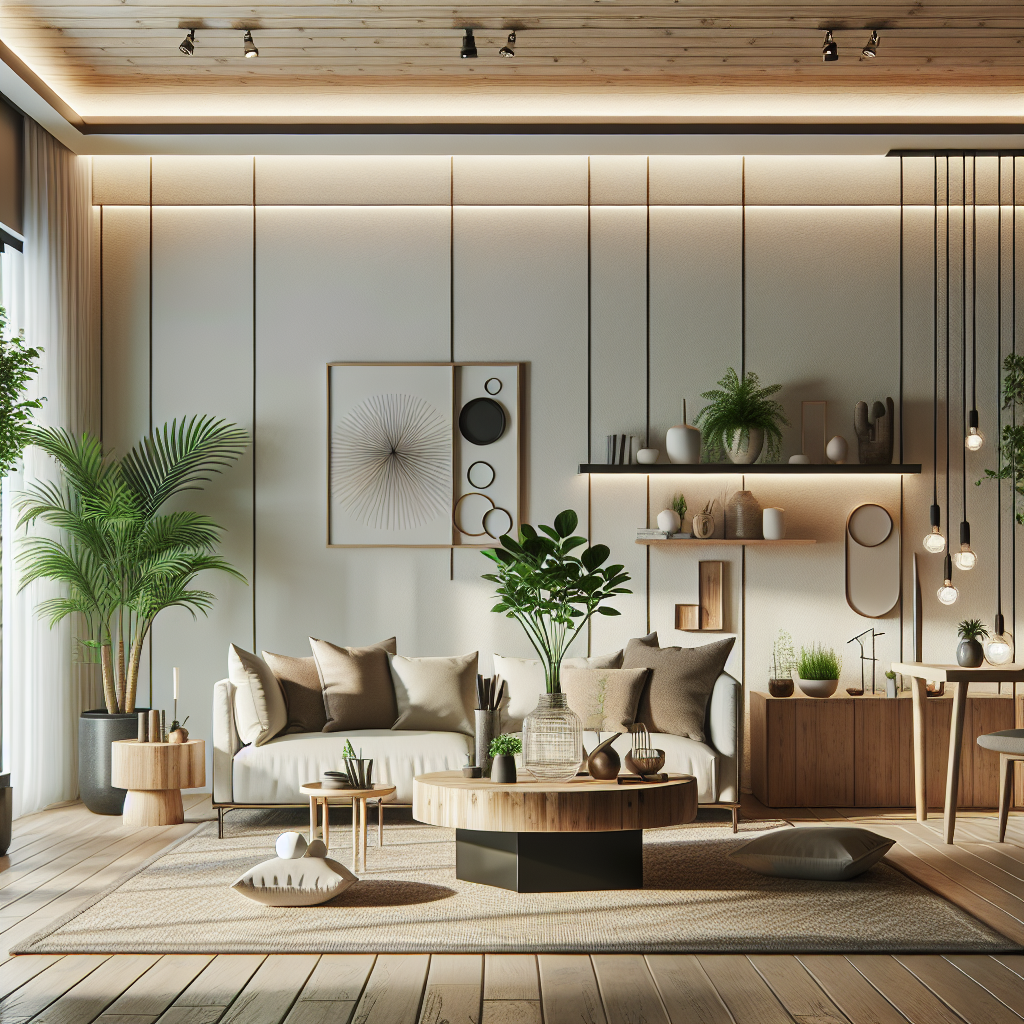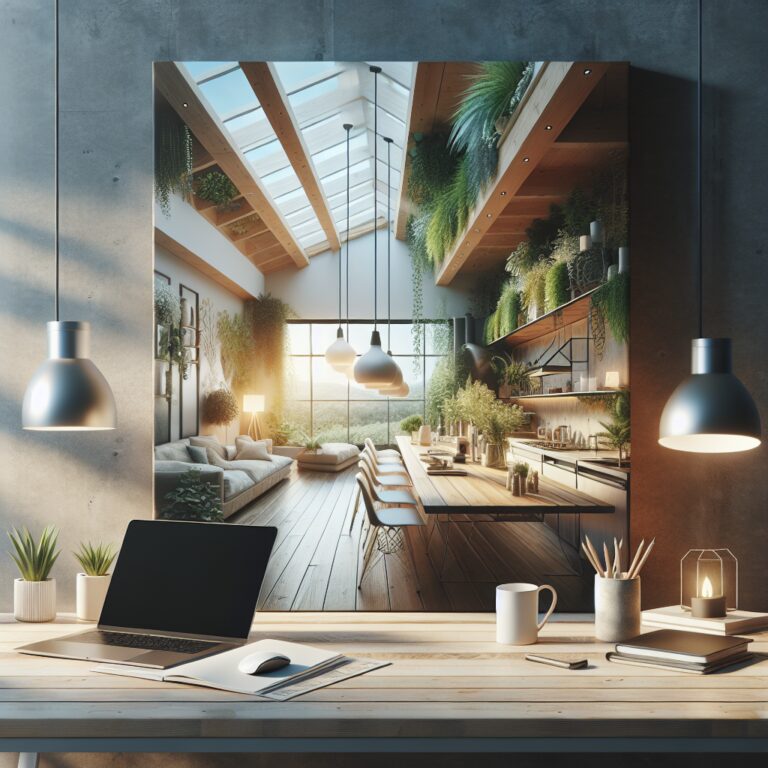Creating a beautiful home doesn’t have to come at the expense of our planet. As environmental consciousness grows, more homeowners are discovering that sustainable design choices not only reduce their ecological footprint but can actually enhance their living spaces with unique character and genuine warmth. From repurposed vintage furniture to energy-efficient lighting solutions, eco-friendly design transforms our homes into personal sanctuaries that reflect our values while protecting what matters most.
*Where sustainability meets style, creating spaces that nurture both our families and our future.**Where sustainability meets style: transforming your living space into an eco-conscious sanctuary without sacrificing comfort or aesthetics.*
Walking into my home used to feel like just another part of my day. Now, after embracing eco-friendly design principles, each return feels like a conscious choice to protect our planet while creating a space that truly nurtures my wellbeing. The transformation wasn’t just physical—it shifted my entire relationship with the concept of “home.”
Why Eco-Friendly Home Design Matters
Every design choice we make carries an environmental footprint. From the materials that surround us to the energy systems powering our daily lives, our homes represent one of our most significant opportunities to align our values with our actions. Eco-friendly design isn’t just a trend—it’s a responsible approach to creating living spaces that respect both planetary boundaries and human needs.
The beauty of sustainable home design lies in its dual promise: reducing environmental impact while often improving our quality of life. Energy-efficient systems lower utility bills. Non-toxic materials improve indoor air quality. Thoughtfully designed spaces enhance mental wellbeing. This harmonious relationship between planet and person sits at the heart of truly successful eco-conscious design.
1. Embrace Natural and Sustainable Materials
The materials we choose form the literal foundation of our homes’ environmental impact. Conventional building and decorating materials often contain volatile organic compounds (VOCs), formaldehyde, and other chemicals that can off-gas for years, compromising indoor air quality and contributing to health issues.
What to Look For
When selecting materials for your home, prioritize options that are:
- Renewable (like bamboo, which regrows rapidly)
- Recycled or reclaimed (giving new life to existing resources)
- Locally sourced (reducing transportation emissions)
- Certified by trusted eco-labels (such as FSC for wood products)
Consider the lifecycle of each material—how was it produced, what happens when it’s eventually replaced, and what environmental costs occur at each stage? For example, cork flooring offers a renewable alternative to hardwood, as cork trees continue growing after harvest, while reclaimed wood flooring tells a story through its weathered character while preventing new tree harvesting.
Simple Swaps to Start With
You needn’t renovate your entire home at once. Begin with manageable changes:
- Replace synthetic throw pillows with covers made from organic cotton, hemp, or linen
- Choose solid wood furniture over particle board options (which typically contain formaldehyde)
- Opt for natural fiber rugs like jute, sisal, or wool instead of synthetic alternatives
These seemingly small choices collectively create a healthier interior environment while reducing your ecological footprint.
2. Maximize Energy Efficiency
The energy our homes consume represents both our largest environmental impact and our greatest opportunity for improvement. A truly sustainable home works with nature rather than against it, using design principles that minimize energy needs while maximizing comfort.
Passive Design Strategies
Before investing in technology, consider how your home’s design can naturally regulate temperature and lighting:
- Strategic window placement for cross-ventilation can reduce or eliminate air conditioning needs
- Thermal mass elements like concrete floors or stone walls absorb heat during the day and release it at night
- Properly sized roof overhangs can block summer sun while allowing winter sunshine
Think of your home as a living system that breathes and adapts with the seasons rather than a static box requiring constant mechanical intervention.
Smart Technology Integration
When mechanical systems are necessary, choose options that maximize efficiency:
- Programmable thermostats can reduce heating and cooling when you’re away
- LED lighting uses up to 75% less energy than incandescent bulbs and lasts significantly longer
- Energy Star appliances significantly reduce electricity consumption without sacrificing performance
Remember Sarah, who transformed her 1960s home by first addressing airtightness and insulation before installing solar panels? She reduced her energy consumption by 60% before generating a single watt of renewable energy—making her eventual solar installation both smaller and more affordable.
3. Design for Conscious Water Usage
Water—our most precious resource—often flows through our homes with little thought to its scarcity. Responsible water design creates systems that respect water’s value while still meeting our needs for cleanliness and comfort.
Inside Your Home
Begin by reducing unnecessary consumption:
- Low-flow fixtures can cut water use by 30-50% without sacrificing performance
- Dual-flush toilets provide options based on actual need
- Front-loading washing machines typically use 30-50% less water than top-loaders
These technologies have advanced significantly—today’s water-efficient showerheads provide satisfying pressure while using just a fraction of the water required by older models.
Outside Your Home
Landscape design presents perhaps the greatest opportunity to rethink our relationship with water:
- Replace traditional lawns with native plantings adapted to local rainfall patterns
- Install rainwater collection systems to irrigate gardens during dry periods
- Create permeable surfaces that allow rainwater to replenish groundwater rather than becoming runoff
A thoughtfully designed yard doesn’t just save water—it creates habitat for beneficial insects and birds, contributing to local biodiversity while requiring less maintenance than conventional landscapes.
4. Prioritize Indoor Air Quality
The air inside our homes is often significantly more polluted than outdoor air, yet we rarely give it the attention it deserves. Creating healthy indoor environments means being intentional about what we bring into our spaces and how air circulates within them.
Choose Low-VOC Products
Conventional paints, finishes, adhesives, and furnishings can release harmful compounds for years after installation. Opt instead for:
- Zero or low-VOC paints and finishes
- Solid wood furniture without added formaldehyde
- Natural fiber textiles without chemical treatments
Consider the story of Miguel, who eliminated his chronic headaches by systematically replacing synthetic home elements with natural alternatives. His journey began with simply switching to low-VOC paint during a bedroom refresh—a change that improved his sleep quality within days.
Bring Nature Inside
Houseplants do more than add beauty—they actively filter air pollutants while connecting us with natural elements:
- Spider plants, snake plants, and peace lilies naturally filter common air pollutants
- Living walls create dramatic visual impact while significantly improving air quality
- Simply opening windows regularly introduces fresh air circulation when weather permits
5. Embrace the “Less But Better” Philosophy
Perhaps the most profound shift in eco-friendly design isn’t about what we add to our homes, but what we choose not to include. Thoughtful curation creates spaces that feel both abundant and purposeful while reducing resource consumption.
Quality Over Quantity
Rather than filling your space with inexpensive items that will quickly wear out or go out of style:
- Invest in fewer, higher-quality pieces designed to last decades
- Choose classic designs that won’t feel dated next season
- Select versatile items that can adapt to different needs and configurations
This approach not only reduces waste and resource consumption but typically results in more satisfying, beautiful spaces that tell meaningful stories.
Multi-Functional Design
Maximize the utility of both your space and your possessions:
- Storage ottomans that serve as both seating and containment
- Extendable dining tables that adjust to different gathering sizes
- Wall beds that transform rooms from sleeping to working spaces
Smart, multi-functional design doesn’t just reduce material consumption—it creates more livable homes that adapt to our changing needs.
By thoughtfully implementing these five principles, you create a home that honors both environmental responsibility and personal wellbeing. Each choice—from the materials that surround you to the systems that support your daily life—represents an opportunity to align your living environment with your values.
The most beautiful aspect of eco-friendly design isn’t just its positive impact on the planet, but how it improves the quality of our immediate experience. A well-designed sustainable home feels more comfortable, promotes better health, costs less to operate, and creates a deeper connection to the natural systems that sustain us.
Your home can be more than just where you live—it can be how you live your values every day.
Final Thoughts: Elevate Your Space with Purpose
Throughout this blog, we’ve uncovered how ceilings, walls, and facades collectively shape environments that inspire and function seamlessly:
Now it’s your turn. What ceilings could you reimagine? Which walls might tell a better story? How could your facade radiate warmth or boldness? Share your breakthroughs below, or grab a paintbrush and start experimenting. Every space deserves to reflect its full potential – including yours.
Your journey begins with a single brushstroke. Where will yours lead?




